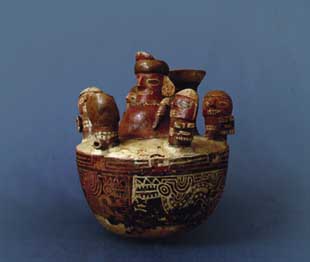|
The mountain culture of Recuay flourished in the years 1-650 A.D. Its central area was situated in northern central Peru, in the heartland of the earlier Chavín culture. Warlike disposition was stressed in the Recuay art, and a number of fortified dwelling places are known in the area. The Recuay people have apparently been divided into small chieftain and village districts that fought among themselves or the neighbouring peoples.
The Recuay ceramics has been made of fine, white kaoline clay. The vessels are thin-walled and rather complex in form. Both sculptural elements and negative and positive painting technique have been used in the ornamentation. Among other things, birds and animals and human and supernatural beings belong to the motif selection. Rich geometricality is characteristic of the painted decoration.
Besides ceramics, also stone cutting was popular. In this respect, the culture carried on the traditions of the Chavín culture. The Recuay sculptures can be divided into two groups, one of which is made up of wall ornaments of buildings, the other about a metre-high statues that stand independently.
|

A so-called chieftain vessel, typical of the Recuay culture, depicts a seated elite person with five subordinates or warriors. In the painted zone at the lower part of the vessel there is the so-called moon animal, a central figure in Recuay art.
© Didrichsen Art Museum, Helsinki
|

